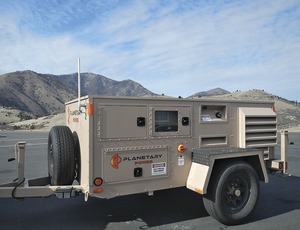


Reinventing the generator is a thankless task. Contractors are used to fueling these reliable workhorses of the construction jobsite and forgetting about them, at least until they need refueling. But Seattle-based Planetary Power may be attracting new attention to these machines with its still-unreleased solar-powered generator, SUNsparq. The SUNsparq generator uses a proprietary lithium-ion battery system to store solar-thermal power generated by a micro-turbine engine, allowing for uninterrupted power 24/7. Planetary Power recently took the computer-controlled battery system of SUNsparq and paired it with a Perkins 403 diesel engine, while it continues development and testing of SUNsparq.
The result was HyGen, a 60-kW diesel-battery hybrid generator that runs primarily off its battery pack during operation, starting up the diesel engine only to recharge the batteries or when operating under high load. The generator's power management is computer controlled, automatically switching between the diesel engine, the batteries or both, as needed. According to Planetary Power, fuel-cost savings of up to 61% are possible because it is not necessary to run the diesel engine all the time.
"What we're hearing from construction industry folks about using remote generators is that they often have to be oversized because at some point during the job you need 60 kW," says Joe Landon, CEO of Planetary Power. "But if you're running at 20 to 30 kW the rest of the time, you're not getting the most out of it. One of the things we've realized is that off-grid applies to more than we thought. Just the convenience of not having to worry about refueling the tank as often can really help on tight schedules."
Brad Wilson, vice president of operations with demolition and asbestos-abatement contractor KD&S Environmental, Montesano, Wash., says the machine did exactly what it was supposed to do on a job overseeing asbestos abatement during demolition of a high school in Shoreline, Wash. The HyGen generator provided onsite power for a team of 15 to 20 workers.
"It's a generator, it puts out power. The fuel cost was ridiculously low compared to other generators' fuel costs," he says. "The power was cut to the building we were in. The majority of the time in jobs like this we have onsite power, but when we don't, we used to rely on smaller generators. On this job, I needed a lot of power and I needed it now."
Wilson's team ran negative-air machines, work lights and air compressors as well as equipment that draws a great deal of peak power like industrial floor buffers and numerous corded hand tools.
"I think we used 38 gallons [of diesel fuel] in two weeks, and [the HyGen] ran around the clock while we were working," Wilson says. "The nice thing about it is that it tells you how full it is and how much power you're using. There's a full computer screen, not just gauges." Wilson estimates that the HyGen consumed between 0.6 to 0.7 gallon of fuel per hour during the job. But although the rented HyGen performed as needed, Wilson was a bit hesitant about purchasing one for his firm. "If I had a use for it more than a month a year, I would definitely buy one. But we have onsite power often, so it just doesn't pay at the moment."
The price tag for a HyGen runs between $85,000 and $100,000, depending on options, which can be a barrier to entry for some markets. Planetary Power has chosen to market the HyGen to jobsites that are remote and hard to reach, where the cost of shipping large amounts of fuel is prohibitive.
"We've found the cost of the HyGen is less of a concern to our customers than actually getting fuel out to the sites," says Landon. He says the firm has interested customers working in extremely remote locations, including towns in northern Alaska and mining operations in the African desert. "Our primary focus is remote sites," he says. "Cellphone towers are one area we are looking at, one generator out in the middle of nowhere that we can monitor remotely."
Landon says Planetary Power is working on a second-generation HyGen that will accept other fuels such as natural gas and propane and could provide outputs up to 100 kW.
"Based on the response we've gotten, particularly at CONEXPO earlier this year, we expect the market for HyGen to grow over the next few years," he says.




Post a comment to this article
Report Abusive Comment